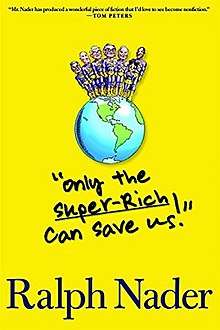Only the Super-Rich Can Save Us!
Only the Super-Rich Can Save Us! is a 2009 fictional work by American political activist Ralph Nader, described by him as a practical utopia, in the style of Edward Bellamy's 1888 utopian novel Looking Backwards.[1]
 First edition | |
| Author | Ralph Nader |
|---|---|
| Country | United States |
| Language | English |
| Genre | Semi-Fiction |
| Publisher | Seven Stories Press |
Publication date | 22 September 2009 |
| Media type | Print (Hardcover) |
| Pages | 736 pp |
| ISBN | 1-58322-903-5 |
| OCLC | 351302240 |
| 361.7/40973 22 | |
| LC Class | HV27 .N33 2009 |
Nader wrote the book to inspire imaginative solutions to the problem of corrupt politicians and financial institutions.[2][3]
Similarity to Atlas Shrugged
Just as Atlas Shrugged portrayed self-interested successful capitalists working to create a "Utopia of Greed" that is free from government, Only the Super-Rich Can Save Us! portrays an altruistic group of super-rich individuals working to "re-make government" and where "the rebellious rich take on the reigning rich."[4]
The novel's protagonist is inspired by Warren Buffett. On August 14, 2011, Warren Buffett wrote an influential op-ed entitled, "Stop Coddling the Super-rich",[5] which argues that the super-rich should bear more responsibility and pay their "fair share" of taxes.
References
- Nader, Ralph. Only the Super Rich Can Save Us! Nader.org. 22 September 2009.
- Long, Rob. One Man's Utopia. The Wall Street Journal. 29 September 2009.
- Khatchadourian, Raffi. Nader’s Blueprint. The New Yorker. 28 September 2009.
- Moyer, Justin. Novel comparison: Ayn Rand and Ralph Nader The Washington Post. 23 October 2009.
- Buffett, Warren. Stop Coddling the Super-Rich The New York Times. 14 August 2011.